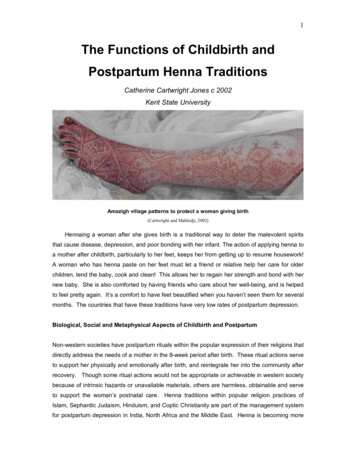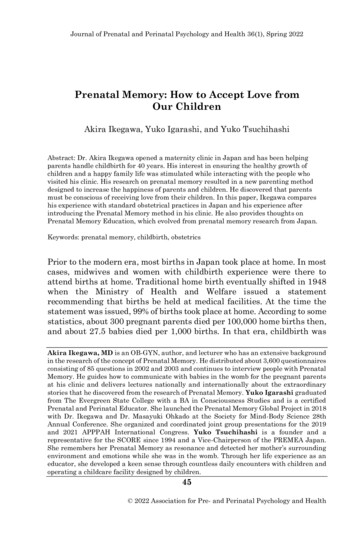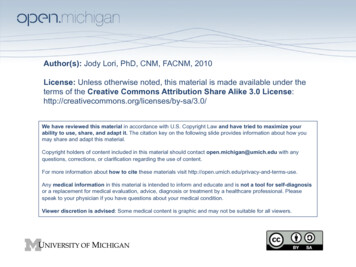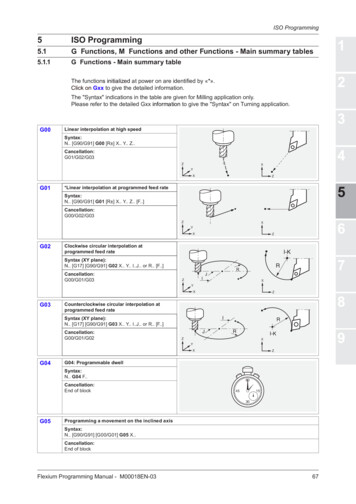
Transcription
1The Functions of Childbirth andPostpartum Henna TraditionsCatherine Cartwright Jones c 2002Kent State UniversityAmazigh village patterns to protect a woman giving birth(Cartwright and Mahlodji, 2002)Hennaing a woman after she gives birth is a traditional way to deter the malevolent spiritsthat cause disease, depression, and poor bonding with her infant. The action of applying henna toa mother after childbirth, particularly to her feet, keeps her from getting up to resume housework!A woman who has henna paste on her feet must let a friend or relative help her care for olderchildren, tend the baby, cook and clean! This allows her to regain her strength and bond with hernew baby. She is also comforted by having friends who care about her well-being, and is helpedto feel pretty again. It’s a comfort to have feet beautified when you haven’t seen them for severalmonths. The countries that have these traditions have very low rates of postpartum depression.Biological, Social and Metaphysical Aspects of Childbirth and PostpartumNon-western societies have postpartum rituals within the popular expression of their religions thatdirectly address the needs of a mother in the 8-week period after birth. These ritual actions serveto support her physically and emotionally after birth, and reintegrate her into the community afterrecovery. Though some ritual actions would not be appropriate or achievable in western societybecause of intrinsic hazards or unavailable materials, others are harmless, obtainable and serveto support the woman’s postnatal care. Henna traditions within popular religion practices ofIslam, Sephardic Judaism, Hinduism, and Coptic Christianity are part of the management systemfor postpartum depression in India, North Africa and the Middle East. Henna is becoming more
2widely available in western countries at present due to the popularization of henna body art inwestern pop culture (Maira S, 2000), so childbirth and postpartum henna traditions ould beperformed.Henna’s association with beautification and protection from evil are comforting.Henna’s requirement that a woman be still for several hours during and after application insuresthat a mother will rest and allow others to take care of her! During the weeks after ornate hennapatterns are applied, a woman is culturally allowed to not do household tasks that would spoil thebeauty of the stains. This increases the likelihood that she will rest properly to regain her strengthafter giving birth.Rajasthani village henna patterns symbolizing the sun, a symbol of blessing and fertilityA woman goes through a social status change when she becomes a mother, and her relationshipwith her husband, other family members, and social group is changed. Caring for and nursing aneonate requires much from woman’s physical and emotional resources. These stresses addedto the precipitous fall in estrogen and progesterone levels following birth, coupled with theelevation of prolactin in the first week postpartum are believed to give rise to irritability, moodchanges, tearfulness, guilt, anxiety, fatigue and feelings of inadequacy. In extreme cases, thesymptoms of postpartum psychosis include agitation, confusion, hallucinations, fatigue, deliriumand diminished thinking (Stern and Kruckman, 1983). Though women universally experience thebiological processes of the postpartum adjustment, they conceive of these changes through theirsocial and religious constructs (Kleinman, 1978; and Cosminsky, 1977). Malevolent spirits or theEvil Eye may be conceptualized as the bringers of depression. When rituals are performed torelieve the woman of the stresses of social reintegration, childcare and fatigue, theconceptualized demons of postpartum depression may be averted as the biological adjustments
3are buffered. Henna is frequently used within performance of rituals actions in North Africa, theMiddle East and South Asia to deter the evil eye. Henna applications also necessarily force awoman to stop, be still, and let other people take care of her while the henna stains the skin, thusinsuring that the mother will rest and allow other people to do her regular tasks.Rajasthani village henna pattern symbolizing the sun, a symbol of blessing and fertilityWestern neonatal practice screens for postpartum depression, recognizes that it exists in severaldegrees of severity, that it is a clinically recognizable affective disorder, and that there arestatistically predisposing socio-economic factors. Traditional cultures recognize that a woman isin a fragile, stressed state after giving birth, and that timely assistance from ritual actions ofpopular religion helps the mother reintegrate into society.In contrast, western medicineconceptualizes postpartum depression as a psychobiological phenomenon to be addressed bymedication rather than a socio-magical phenomenon to be addressed by ritual performance.Childbirth and Postpartum Ritual Actions with Henna and Rangoli in Rural RajasthanPostpartum practices in Rajasthan are typical of those throughout rural regions in India.In rural Rajasthan, ritual actions surrounding childbirth include henna applications and rangolii.A woman in the eighth month of her first pregnancy has an Athawansa ceremony. She rubbedwith scented oils, bathed in perfumed water, and ornamented with henna, on her hands, feet, upto the wrist and ankle, in a manner similar to her wedding henna. She is dressed in new clothingand ornaments. She is seated on a cauki, ceremonial wooden seat. Women friends and familyfill her lap (god) with sweets, fruit, and a coconut. This ritual is god bharna, or the filling of the
4lap. Women ornament the floor with rangoli called “Athvansa-ko-cowk” (Saksena 1979:121). Thepatterns used are acknowledged to bring health, protection and luck to the new mother and herchild by inviting the aid of supernatural forces. Primiparous women are statistically most at riskfor postpartum depression, and prenatal screenings for depression are often carried out inwesternRajasthani henna patterns symbolizing the sun, a symbol of blessing and fertilitymedicine at this period (Stern and Kruckman, 1983). The eighth month ritual may serve toestablish the woman’s “social safety net” within her community, who will help her through birthand reintegrate her after childbirth. The similarity of this henna to her wedding henna may remindher of the joyous occasion of her wedding, and raise her spirits if she has become anxious.Women are reminded that pregnancy and birth is the successful fulfillment of their marriage. Atbirthing, the mother is ornamented with henna before being escorted out of the delivery room.After the woman has given birth, she must have all of her fingernails and toenails hennaed in aceremony known as Jalva Pujani, as henna is considered a medium for purging the pollutionincurred from the process of giving birth (Saksena 1978, 75). If she is not properly hennaed atthis time, she is considered at risk of not recovering from birth. For the first 9 days after birth, thewoman is secluded and attended to by female relatives. The Rajasthani enforced rest, physicaland emotional support during the establishment of maternal bonding and lactation may be crucialin preventing or relieving postpartum depression, and are similar to those observed in Nepalwhich are also considered to manage postpartum stress (Upreti, 1979)
5Rajasthani village henna patterns symbolizing the sun, a symbol of blessing and fertilityOn the tenth day after giving birth, the mother comes out of her rooms for the first time for theSuraj ceremony. This is the Namakarana Sanskar Divas, or the name-giving day, and the child isshown to the Sun to obtain the deity’s blessings. Solar symbols are applied in henna to themother and to the child. Solar symbols are drawn in rangoli in the household courtyard. Thechild is presented to the deities, the community and the mother assumes her new social status.The sun, in Hindu religious iconography, is understood to be a caring and protective deity,providing relief from infertility, hunger, and the sorrows of old age and death (Malville and Singh,1995). Ritually integrating the mother and child with the benevolent forces of the sun serve tosmooth the transition from ritual postpartum seclusion back into active village life, and have abuffering effect against the stresses of new motherhood. If an immigrant woman does not haveaccess to her accustomed rituals: henna, rice flour to create rangoli, and friends and practitionersto assist her, apply the henna and paint the patterns, her anxiety and fatigue following birth maybe unrelieved and develop beyond “baby blues” into a prolonged disorder (Stern and Kruckman1983).
6Childbirth and Postpartum Rituals in Early 20th Century Amazigh MoroccoWomen arriving in the west as refugees from North African famines and wars often haveinsufficient English to express their concerns to medical personnel, leading to misunderstandingsabout their need for performance of ritual actions surrounding childbirth. Westermarck (1926)and Legey (1926) recorded meticulous descriptions of the henna traditions and other ritualperformances surrounding childbirth in Morocco in the early part of the 20th century. These arecomparable to traditions practiced throughout North Africa prior to modernization in thosecountries. Contemporary urbanized North African women now often regard these traditions as“country”, but they are still practiced in rural areas, and may be reconstructed by women whohave nostalgic feelings for their traditions, or who feel comforted by the old rituals.Amazigh village patterns to protect a mother from the Evil EyeWomen routinely arrive in North African maternity clinics with hennaed hands and feet. If theyhave immigrated to western countries, physicians unfamiliar with the tradition may mistake theirhenna patterns for skin disease, creating a stressful misunderstanding between doctor andpatient. Physicians are often unaware that hennaeing fingernails and toenails does not alterpulse oxymetry readings (Al-Majed, Harakati, 1994) as does fingernail polish, and may insist thatthe woman try to remove the henna.In most of the tribal groups, women were hennaed, andornamented with kohl (a traditional black makeup made of antimony) and swak, (a traditional darklip stain made of walnut root) as if they were brides before they go into labor. These not onlydeterred malicious spirits, but also prepared the woman for the possibility of dying in childbirth. Ifa woman died in childbirth, she was believed to enter paradise as a bride, and should beappropriately adorned (Westermarck II, 1926, 383). A woman who died in childbirth was believed
7to have no punishment after death (Legey, 1926: 119). Women in western maternity clinics arewell supported medically to prevent death in childbirth, but no attention is given to her potentialentrance into afterlife.Amazigh village henna patterns to protect a mother from the Evil EyeAn Amazigh woman who gave birth to twins was regarded as full of baraka, or blessedness, andthose who visited her after birth would kiss her hand and address her as lalla, “my lady”. If awoman gave birth to triplets she was regarded as holy. Even an ordinary birth was believed tohave baraka (Westermarck I, 1926, 47). Though birth is regarded as a wonderful event, animmigrant woman in a western hospital maternity ward is unlikely to feel very special. If she givesbirth to twins or triplets, they are swiftly removed to a neonatal intensive care unit for monitoringand health support, and treated as a medical emergency rather than being celebrated. Multiplebirths in the have a high statistical correlation with impaired maternal bonding and postpartumdepression in western pediatrics (Stern and Kruckman 1983).The midwife attending the birth in North Africa took care to assure the woman that malicioussupernatural spirits were dispelled. This was accomplished with henna, incense, amulets, andritual actions. In Moroccan Jewish households, a magic circle was drawn in the air around thelaboring woman with a large sword to deter evil spirits. At the moment of birth in AmazighMorocco, the mother was kept covered, with only the midwife can attending her, so the “evil eye”could not catch sight of her genital organs and cause her harm (Legey, 1926: 124). A laboringwoman was therefore in a secure and familiar place, undistracted, accompanied only by onetrusted helper.Several strangers peering between her legs, bright lights, and machinessurround a woman in a western obstetric ward. These are helpful in insuring hygiene, medical
8expertise, and optimize chances for a healthy delivery, but can be unsettling to the mother if sheis not familiar with western medical practice.Amazigh village henna patterns to protect a mother from the Evil EyeThe child’s umbilical cord was dabbed with henna, and was disposed of through ritual action inmost North African and Middle Eastern groups. When an Ait Yusi child’s umbilical cord fell off, itwas buried under the household’s roof-pole, with barley, salt and henna, to protect the child fromjealous spirits. The knife used to cut the umbilical cord was first put under the child’s head toprotect it from malicious spirits, and then was used to cut the meat of a sheep or goat sacrificedon the seventh day after birth. Among the Hiana, the cord and swaddling clothes were buried orthrown into a river, along with the knife that cut the cord, lest an enemy find these things andpractice magic with them. In Andjra, the midwife daubed henna on the umbilical cord and buriedit with the afterbirth at a local saint’s shrine to insure supernatural protection (Westermarck 1926,II, 372-3). Western obstetrical practice may conserve the placenta and umbilical cord for researchpurposes. The birthing surgical instruments and linens are be autoclaved and reused, or ifdisposable, will be incinerated or sent to a landfill. If a woman believes that strangers or spiritsmay access these and thus deliberately or accidentally harm her and her child, her anxiety maycontribute to postnatal depression.Not all henna rituals following birth are advisable in the urban setting. Though henna is quite safefor a woman, it is not safe for a newborn. Henna was applied to an infant soon after birth in most
9North African and Middle Eastern cultures to deter evil spirits. The henna was mixed with oil orbutter and applied as a cleansing massage to the child during the seven after birth (WestermarckII 1926: 383-5). Henna is a sunblock and anti-dessicant, as well as having mild antibacterial andantifungal properties, which would have had some benefit in desert nomadic circumstances.Because the child was not washed for the first seven days, the henna rub may have helpedcleanse the baby, and been more benign than a contaminated water supply. However, it is notmedically advisable to henna a child, as henna is acidic and upset the infant’s undeveloped acidbalancing mechanism. Full body henna application can also hemolyze blood cells in a newborn,and exacerbate neonatal anemia, with potentially fatal results in premature children. In ruralSaharan conditions, henna mixed with olive oil or butter was probably less apt to kill a newbornthan a polluted water resource.Amazigh henna patterns to protect a mother from the Evil EyeAn Amazigh woman was repeatedly ornamented with henna during the seven days after birth, aswell as having her eyes rimmed with kohl. She was kept secluded, and only the midwife wasallowed to attend her behind her curtain. This was seen as a safeguarding the mother againstmalicious spirits and witchcraft that would cause her illness, depression and death (WestermarckII, 1926, 385). The effect of these ritual actions was to allow the mother to rest and be cared forby an experienced attendant during the 10 day period required for her estrogen, progesteroneand prolactin levels to stabilize and for her to recover her strength (Stern and Kruckman 1983), aswell as being comforted by ritual actions familiar from her wedding. Neither mother nor child werewashed with water during this period, but were cleaned with oil and henna. At each application of
10henna, the woman would have to remain still for several hours, resting, and allowing others totake care of household tasks, ensuring that she would regain her strength quickly.Amazigh henna patterns to protect a mother from the Evil EyeOn the seventh day after birth, the child was washed and named. A Bishmillahii was spoken, thechild’s name announced, along with the parent’s names, so that if a child died in infancy it couldfind its parents in the afterlife. If the child was a son, a ram was slaughtered in its honor, and thechild’s name was spoken at the moment of sacrifice. A feast was prepared for the mother andchild and the mother’s secluding curtain would be opened. In Andjra, the midwife again adornedthe mother with henna, and dressed her in clean clothing. The child was also hennaed on thehead, neck, navel, feet and fingernails, in its armpits and between the legs, all in an effort to avertmalicious spirits. The mother was dressed with slippers on her feet, and her head was covered,leaving only eyes, nose and mouth uncovered, so that witchcraft or malicious spirits would notcause her mental or physical illness. The mother still abstained from work at this time, thoughshe directed household tasks. Women in the house trilled a zgrit several times at the birth of ason, fewer at the birth of a daughter (Westermarck II, 1926: 386 – 94) to dispel evil spirits.At the seventh day and days following, the family put on as extensive celebration as could beafforded. Female relatives who visited during this period assisted household tasks so the mothercould continue to rest. Music and feasting was arranged to celebrate the birth, and the motherwas dressed in fine clothing, hennaed, harquuesed, her hair dressed in fragrant oil and rosewateras if she were a bride.She was given the heart and fat of the sacrificed animal to eat
11(Westermarck II 1926: 397), one of the few times that a woman was guaranteed abundantcalories and protein.Again, elaborate henna ensured that the mother would rest for severalhours during and after the application. She would be excused from household chores for thefollowing weeks to keep her henna stains beautiful, so the henna encouraged continued rest andrecovery.For forty days after giving birth, the woman was regarded as unclean and in a delicate state oftransition. The phrase often spoken was that “her grave is open”. Marital intercourse was notresumed until forth days after birth in most of the communities, though a man could return tosleeping by his wife after the seventh day. For forty days, if not longer, the child was kept inswaddling clothes, and never left alone, lest malicious spirits come and steal it, exchanging it fortheir own (Westermarck II, 1929: 398-9). During this period, maternal bonding was not impairedby separation as is common in western medical obstetric practice. A woman suffering postpartumdepression may assert, “The child is not my own, or I am afraid of my baby.” (Brockington et al,2001: 136 - 8). The North African ritual actions managed the risk of postpartum psychosis bykeeping mother and child together, supported and undistracted during the 40-day period whendepression is most likely to appear. If a depression or psychosis did develop and woman felt thather child had been stolen and replaced by a supernaturally evil creature, (medical literature notespostpartum psychoses can take the form of the mother believing the child to be evil or malicious(Brockington et al, 2001)) rituals were be performed to retrieve the natural child so maternalbonding could be re-established. The infant believed to be a changeling, a mebeddel, had to betaken back to the jnun, supernatural spirits, and exchanged for the human child. The mother tookthe evil creature to a cemetery, looked for a demolished tomb, and put the changeling child there,with an offering of meat for the jnun. She withdrew, to avoid contact with the spirits as they cameto collect the meat. As soon as the child cried, she reclaimed it, and washed it with holy water,and exclaimed, “I have taken my own child, not that of the Other People” (Legey, 1926: 154 – 5).Thus the postnatal ritual actions acted to buffer depression, and offered an option for reinstatingmaternal bonding in the instance of psychosis.Popular Religious Ritual in Addition to Formal Religious Ritual and Standard MedicalPractice Can Assist Immigrant Women After ChildbirthFormal religious ritual addresses the metaphysical needs of a mother and child after a birth. Abaptism, priest’s blessing, or circumcision secures the child’s soul into the formal religiouscommunity.The mother and child’s souls and their relationship with God are established andrenewed through prayer, visits to a religious edifice, reading scripture, and blessings by clergy.These formal rituals and blessings are largely directed towards integrating the child into the
12metaphysical community, but there are no comparable formal rituals for the mother’s statusadjustment. Mosques, temples, and the other expressions of formal religion may be establishedwithin an immigrant community as soon as there is enough economic base to support such.Though these supply the formal metaphysical needs of mothers and children, they may notprovide the popular rituals for social and emotional support during the postpartum period.Adopting pluralist approaches to popular as well as formal religious practices may assistimmigrant women in adjusting to motherhood with more moderate rates of postpartum depressionthan are currently experienced.Performance of postpartum rituals, particularly those which include henna, for South Asian,Middle Eastern and North African women during the forty days after birth may reduce their highlevels of depression in their host countries to levels found in their indigenous countries. It isnotable that these rituals are performed to provide physical and emotional assistance, and enablethe woman to recuperate and bond with her infant through the period wherein the woman is mostat risk for postpartum depression due to hormonal adjustment.In particular, the hennaapplications during this period require a woman to rest quietly for hours during the process, andabstain from household tasks that would spoil the patterns for three or four weeks following. Thisenforcement of inactivity ensures that a woman will rest during the period of hormonalstabilization and bond with her infant. If ritual performance can achieve similar reduction indepression to SSRIs, and do not directly interfere with medical practice, then religious pluralismmay be practical medical policy.Diversity in formal religious practice is acknowledged and respected in western medical practice.Popular religious practice, particularly when directed towards healing, is often viewed doubtfully, ifnot rejected by western medicine. Formal religious practice tends to a mother and child’smetaphysical needs, but popular religious ritual provides comfort and relief of their emotional andphysical needs. An immigrant woman may have access to her formal religious rituals, but not toher accustomed popular rituals in the 40 days following birth, and the absence of those popularreligious rituals may put her at increased risk for postpartum depression.Women recently immigrated into western countries have up to 10 times the incidence ofpostpartum depression in comparison to their peers in their native non-western countries and incomparison to women acculturated to the west (Bashiri and Spielvogel, 1999). New mothers innon-western cultures display few symptoms of postpartum depression; some sociologists believethat the women may be so well supported by their postpartum rituals within their countries oforigin this affective disorder is nearly eliminated (Stern and Kruckman, 1983). Other studiesdemonstrate that the physical and emotional stresses following childbirth are well identified and
13managed by ritual in the indigenous community, so that the experience of depression isminimized (Pillsbury, 1978). Immigrant women’s lack of access to their postpartum rituals in theirhost country has been proposed as a cause of this elevation in psychiatric morbidity (Lee et al,1998; Moon Park and Dimigen 1995). In North Africa, women who feel they are suffering frompostnatal illness seek help from a traditional healer rather than from a physician (Cox, 1983), andsuch preference is common in other countries. The women feel that their needs for postpartumreorientation and support are better met by popular religious ritual rather than formal religion orwestern medical practice. When they are immigrants into a western country, the formal religionmay be available, but performance of appropriate popular religious rituals for childbirth may beimpossible do to lack of knowledgeable practitioners and implements for performance.Rajasthani village henna patterns symbolizing the sun, a symbol of blessing and fertilityWestern Medical and Popular Religious Ritual Approaches to Birth and PostpartumDepressionWestern doctors understand that their patients are religiously and ethnically diverse, but they areselective about which religious/medical actions they are willing to tolerate or perform. Westernneonatal practice is willing to perform male circumcision, but not female circumcision. A priestmay be admitted into a hospital setting to bless a child, but a large group of women loudly trillinga zgritiii to bless a child (Westermarck 1926, II, 375) might be unwelcome. A woman may be ableto order kosher or vegetarian food for her hospital stay, but not exotic foods required by popularreligious ritual in her country of origin. Women in obstetric wards receive flowers from a florist,but are usually discouraged from decorating their bedposts with traditional textiles to deter evilspirits, as only sterilized bedding and autoclaved instruments are permitted. An obstetrical roomwill be cleansed with antibacterial spray, but anti-smoking regulations may be interpreted to
14prohibit cleansing censing with gum-sandarach, which rural Moroccan women believe to excitefear in malevolent spirits (Westermarck 1926, II, 382). A woman going into surgery is required toremove all jewelry, even if that includes amulets and talismans that she feels are crucial to insurea safe delivery. Western physicians often mistake henna for skin disease, and may dismiss othertraditional postnatal rituals as unhygienic or medically useless. If performance of postnatal ritualscan be demonstrated to significantly reduce maternal psychiatric morbidity incidence in immigrantwomen, they are NOT medically useless! In addition, there is concern that selective seratoninreuptake inhibitors prescribed by physicians to depressed mothers are found in their breast milk.The long-term effect of antidepressants consumed by infants through breast milk has not beenassessed for possible side effects, though it is noted to cause sleep disturbance (Schmidt,Olesen, Jensen, 2000).A mother may be asked to choose between breastfeeding anddepression if a western doctor offers her only SSRIs to assist her postpartum depression. Ifperformance of traditional postpartum rituals could reduce depression to levels achieved withmedication, such a choice might be avoided.Though the formal religious practice may be established in the host country, the social networkand implements necessary for popular religious ritual may be unavailable (McCarthy and Barnett,1997). Popular religious rituals often require implements rarely available outside of a country oforigin: indigenous plant and animal products may only be imported where there is a communitylarge enough to make such economically practical. Henna, rice flour, live rams for sacrifice,kumkum powder, kohl, incenses, mustard oil, talismans, amulets and similar articles used withinritual performance may not be available, and if found, there may be no practitioners capable ofperforming the rituals.An immigrant woman may thus be unable to access the rituals sheregards as necessary for purifying and reintegrating her into society after giving birth. This hasbeen considered contribute to the elevated and prolonged postpartum depressions observedamong immigrant women (Williams and Charmichael, 1985). The immigrant’s lack of the usualsupport network to perform popular religious rituals following birth has been associated with theelevated maternal psychiatric morbidity in their host countries (Upadhyaya et al, 1989, Watsonand Evans, 1986)
15References:Al-Majed S A, Harakati M S, “The Effect of Henna Paste on Oxygen Satureation Reading Obtained by PulseOximetry”Tropical and Geographical Medicine 46 #1, 1994, p 38 – 9Barnett B, Matthey S, Gyaneshwar R, “Screening for Postnatal Depression in Women of Non-EnglishSpeaking Background”Archives of Women’s Mental Health, 2: 67-74, 1999Bashiri N, Spielvogel A M, “Postpartum Depression: a Cross-Cultural Perspective”Psychiatry Update, Elsevier Science Inc, 1999, 82 - 87Brockington I F, Oates J, George S, Turner D, Vostanis P, Sullivan M, Loh C, Murdoch C; “A ScreeningQuestionnaire for Mother-Infant Bonding Disorders”Archives of Women’s Mental Health 2001, 3: 133 - 40Cosminsky S, “Childbirth and Midwifery on a Guatemalan Finca”Medical Anthropology 1, 69 - 104, 1977Cox J L, “Postnatal Depression: a Comparison of Scottish and African Women”Social Psychiatry, 1983, 18, 25 - 28Ghubash, R. Abou-Salen MT, “Postpartum Psychiatric Illness in Arab Culture: Prevalence and PsychosocialCorrelates”British Journal of Psychiatry, 171: 65-68, 1997Kleinman A, “Culture, Illness and Care – Clinical Lessons from Anthropological and Cross-CulturalResearch”Annals of Internal Medicine, 88, 251-258, 1978Lee, Yip, Chiu, Chan, Chau, Leung, Ch
Childbirth and Postpartum Rituals in Early 20th Century Amazigh Morocco Women arriving in the west as refugees from North African famines and wars often have insufficient English to express their concerns to medical personnel, leading to misunderstandings about their need for performance of ritual actions su










